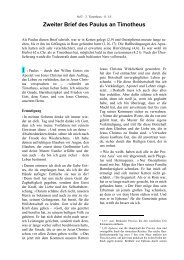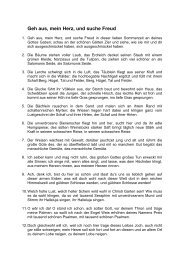You also want an ePaper? Increase the reach of your titles
YUMPU automatically turns print PDFs into web optimized ePapers that Google loves.
The ear<br />
– our highest-precision<br />
<strong>sense</strong> organ<br />
Without the <strong>sense</strong> of hearing we would lack an<br />
important method of orientation. Like a bird in<br />
a small cage, we would then be largely excluded<br />
from everyday events,. Sounds intensify the sensory<br />
impressions of life. We can listen to the murmur<br />
of rippling wavelets at our feet, while at the<br />
same time hearing the booming of the mighty<br />
breakers rolling in from the ocean. When taking<br />
a stroll, we enjoy the humming of bees flitting<br />
from blossom to blossom, as well as the exuberant<br />
song of a lark. We can hear a wide range of sounds,<br />
from the soft whining of a mosquito to the earshattering<br />
noise of a jet plane taking off. The racket<br />
of pneumatic drills and other noisy machines<br />
are also part of our everyday experience. Although<br />
these sound signals reveal their origin, they do not<br />
convey any personal messages to us.<br />
no science has as yet been able to attain, or even<br />
(in many aspects) to understand? For the purpose<br />
of describing this, we need a few technical terms,<br />
which will first be explained:<br />
Sound level: Vibrating objects (like a tuning fork,<br />
the cone of a loudspeaker, or human vocal<br />
chords) induce vibrations in the surrounding air.<br />
Adjacent air molecules are accelerated, causing<br />
waves travelling at a speed of approximately<br />
330 m/s. This phenomenon is called sound, and<br />
in a sound field there are zones where air molecules<br />
are more densely packed than in other<br />
zones. Air pressure is greater in the denser zones,<br />
and smaller in the less dense zones. Sound vibrations<br />
can be depicted as wave-shaped graphs.<br />
The distance between two adjacent locations<br />
where the air pressure is the same, is known as<br />
the wave length. The maximum deviation from<br />
the neutral value is called the amplitude. If the<br />
wave length increases (implying a decrease in the<br />
number of vibrations per time unit), the pitch of<br />
the sound becomes lower. And, vice versa, when<br />
In addition to receiving sounds, we can also<br />
transmit them. Speaking and hearing comprise<br />
our basic method of communication. In this case<br />
the kinds of noises and their significance are<br />
completely different. Musical notes, songs, and<br />
the spoken word bear meaningful messages. The<br />
act of identifying their inherent meaning involves<br />
much more than merely processing the received<br />
sound waves. A special evaluation system, located<br />
in the brain, is required for this purpose.<br />
Without the brain we would not have been able<br />
to hear. <strong>Our</strong> souls are stirred by what we hear, as<br />
expressed by the poignant French proverb: “The<br />
ear is the way to the heart.”<br />
In our contact with the world our <strong>sense</strong> of hearing<br />
is just as important as our vision. Sounds are air<br />
vibrations which are detected by our ears, where<br />
they are first converted into hydro-dynamic vibrations,<br />
and subsequently into electrical nerve<br />
impulses. Finally the brain identifies these signals<br />
as information.<br />
Did you know that the human ear is a detection<br />
device which utilises a level of technology that<br />
<br />
<br />
<br />
<br />
The curved rim<br />
of the helix forms<br />
a tunnel or flume<br />
The root of the<br />
helix (Crus helicus)<br />
Concealed opening<br />
of the external<br />
acoustic meatus<br />
Lid of the ear (Tragus)<br />
Antitragus<br />
Concha (a hollow depression)<br />
Antihelix<br />
Helix<br />
Gateway to the flume of the helix<br />
Darwin's tubercle<br />
<br />
<br />
<br />
<br />
<br />
<br />
21
















